Consumer Awareness and Fast Fashion
Chapter 1: Research Background
1.0 Introduction
Fashion is one of the most important businesses in the UK, wherein a higher number of clothes are purchased as compared to people as compared to other countries across Europe. Fast fashion is a word that explains the already available and cheaper made manner. The ‘Fast’ term is used to describe how readily the retailers the fashion outfits reach to retailer’s store. The rise in globalization and global economic enhancement has increased the supply chain growth globally and the manufacturing of the textiles. The increase in consumption makes the production of cheaper clothes, and the prices are minimized (McNeill &Moore, 2015). The fashion industry had added £32 billion to the economy of the UK in the year 2017, wherein it employs approximately 890,000 people in different sectors of fashion. It is found that more than the clothing of value $500 billion is wasted each year because of underutilization and lack of recycling. Moreover, the rapid growth of the population in the UK has also raised pressure upon the production of the clothes, which have further enhance carbon emissions. There is also increased usage of natural resources due to increased growth of demand. The process of designing clothes has led to negatively affecting the world and has also affected sustainability (Valor, Carrero&Redondo, 2014). The fashion industry is an industry which has affected the environment and has a significant impact on the purchasing decision of the consumers. The concern has been developed due to overconsumption and over-production of the clothes which generate a larger amount of waste. The lower price of the garments has further increased the demand for clothing, and customers are getting things at pocket money prices. This has declined the quality of the products and is not feasible for recycling. However, the increased trends of fashion clothing have led to damage to human rights, human health, and the environment (McNeill & Moore, 2015). These studies are beneficial as they have analyzed the primary reasons for the overproduction and have studied the outcomes of the overproduced clothes. This study will provide awareness among UK customers regarding the effects of production on the environment and might encourage them to purchase limited garments. Moreover, irrespective of the other study, this research will also explain the influence of clothes overproduction over the purchasing decision making of the customers. This study will be highly essential for those UK customers who are deprived of the knowledge regarding the consequence of overproduction of clothes. This study will apply quantitative research methods and questionnaires as a data collection tool. This study will collect information from questionnaire survey through closed-ended questions. The respondents will be selected from the UK using purposive sampling.

This study will possess five chapters wherein the first chapter explains the overview of the research study. Chapter Two is termed as a literature review that explains the theoretical framework and secondary data which are introduced before the research study. The research methodology will be the third chapter, which will describe the process of research and will showcase the problems associated with research philosophy. Chapter four will be the discussion and analysis chapter, which will review the findings and interpret it based on collected data. The last section will conclude the research study and will sum-up the attained data and information.
1.1Research Aim
This research aims to analyze the impact of the overproduction of clothes in the purchasing decision making of the customers in the fast fashion industry in the UK.
1.2 Research Objectives
The objectives of this research are as follows:
To review the reason for overproduction and its impact over the environment
To analyses the effect of environmental hazards due to textile production
To analyze the effect of overproduction upon the purchasing decision-makers in the UK fast fashion industry
To acknowledge the Behavior and decision-making process of customers
2.0 Literature Review
2.1 Concept of the fast fashion industry
According to Resta &et.al. (2016) Fast fashion is defined as the collection of cheaper price apparel, which is imitated from the present luxury trends of fashion. The demand for the fashion outfits is the main reason for the modern textile and clothing industry. The present system of fashion needs rapid change in style, regular renewing of products, a higher range of variety of products, and reasonable prices. It is originated in the past 1990s, wherein fast fashion was linked with speed. The popularity of the fast fashion system gained recognition among retailers who have adopted vertically integrated business models and different strategies (Lu, Bock& Joseph, 2013). This was possible due to advancements in technology, control in the supply chain, effective transportation, and enhancement in a variety of products. The targets of this industry are those customers who have the knowledge and are passionate about changing trends and fashion. Since each of the targeted customers wants the catwalk items but couldn’t afford them all, so taking such things as an opportunity, a larger number of companies have started producing fashionable items and products at reasonable or cheaper prices. The increased supply chain for fast fashion has acted as a continuous cycle that requires designers, manufacturers, and retailers to act in a pacer manner. The speed of the availability of the product has become the make a point of attraction for the targeted customers (Resta & et al., 2016). Moreover, the availability of fashionable products at cheaper and reasonable price further make the accessibility of the products to every class of people. Fast fashion has also made the disposability as another essential element wherein the company provides a maximum of ten washes as a point of reference later in which the product is not likely to possess its original quality and value. This is a strategy which is applied by each of the fast fashion industry to increase demand for the product and grow constantly. The attraction of the consumer towards fast fashion has maximized in a greater extends and has led to global outcomes.
2.2 Notion of Textile waste
As per Valor, Carrero, &Redondo (2014), Overproduction is the term which is used in the fashion industry when there is an excess amount of production of apparel. The process of textile production and its results possess a larger number of steps wherein it leads to environmental injustice. The fats fashion system not only diminishes and wastes natural resources but even boosts the consumers to view the apparel as disposable. It is found that more than 30% of the clothing and textiles are never sold, and other 1/3rd clothes leave the shop with some discounts. Moreover, $210 billion is the value of distortion of inventory in the global fashion industry, which is the gap between what is required and what is present in the stores. There are 152 items on average with the citizen of the UK in their wardrobe, wherein more than half of them are never worn. The net costs of the unworn clothes in the UK are equal to $45bn, which occupy approximately 5% of the space of the landfills. The present model of textile and clothing production has led to a greater quantity of textile waste as clothes are not used after it is worn for a shorter period. The clothes which are not sent to the landfill directly generally results in the secondhand clothing trade. There are approximately 500,000 tons of used clothes that are exported from the United kingdom annually to developing and under-developed countries. Those secondhand clothes are exported overseas and are sold to low waged workers in second-hand markets of under developing and developing countries. The clothing which is not sold turns out to be solid waste. There are generally three types of textile waste, which include post-industrial waste, pre-consumer waste, and post-consumer waste. There is plenty of waste which is generated during the time of manufacturing whereby several clothes are not made effectively during manufacture. The majority of the waste is also generated at the site of manufacturing or also on the distribution center of retailers. Lastly, waste generation is also done by consumers because of damaged, torn out, or unwanted clothing. It is highly challenging for these industries to manage and reduce the amount of waste generation and other associated activities.
2.3 Environmental hazards due to textile production
According to Strahle (2017), The initial step in the fashion industry is the production of textiles, which is the process through which there is the manufacturing of natural and synthetic fibers. The majority of the clothing is made using cotton and polyesters, which ultimately have an impact on health due to its insignificant production and manufacturing process. There is the usage of a larger amount of pesticides and waters to grow cotton. At the same time, polyester is also obtained from oil, which not only affects the environment but also minimizes the natural resources. Apart from it, the dyeing of textiles also brings out harmful chemicals wherein those untreated waters are liquidated in a different small system of water, which has its adverse influence on the health of plants and animals across it (Strahle, 2017). The production of a larger amount of lower quality clothes with the usage of artificial fibers also diminishes the natural resources. and deteriorate it. The majority of the country is not aware of the intensive resources and are not able to see the footprints of water and carbons. It is seen that if the rate of consumption of the fashion keeps on increasing at an alarming rate, then it will not only minimize the natural resource but will also act as a threat to the quality of life of the future generation(Manchiraju & Sadachar, 2014). In addition to that, textile production is also a contributor to the change in the climate. It generates an average of 1.2 billion tons of carbon dioxide equivalents annually, which is even higher than the carbon produced by international flights and other shipping transportation. There is an estimation that the clothing industry produces a carbon footprint of approximately 3.3 billion tons, which is growing in a pacer manner in the UK (Manchiraju & Sadachar, 2014). It has risen from 24 million tons to 26.2 million tons by the end of 2016 as per the WRAP. It has also made an estimation that there was a usage of 8 billion cubic meters of water in the UK by the end of the same year to produce clothes. The fiber's growth and production have consumed a more significant amount of water. It is also used while dyeing washing and finishing clothes. The addition of rips and tears in the jeans through chemicals is hazardous for workers and the environment. The usage of land for natural fiber production could cause deforestation and loss of biodiversity (Grubor &Milovanov, 2017). This industry has utilized 35% of the area to produce fibers, which could have been applied to grow crops. Thus, it can be stated that the growing demand for fashion outfits has led to a more significant impact on the environment.
2.4 Behavior and decision-making process of customers
Kozlowski, Searcy &Bardecki (2018) have stated that Consumers behavior is the process where a group of people purchases, choose and utilize products to attain satisfaction which is also an essential part of marketing.there are three roles of consumers which includes payer, user, and buyer wherein each of the characters is the part of the decision-making process. This process initiated from the recognition of the needs of customers and finds out ways to solve their needs. When there is the establishment of the problems and needs, customers start searching the information which is evaluated, and selection are made based on planning and data found which lastly ends up in purchasing decision (Grubor &Milovanov, 2017). There are various types of the decision-making process which are linked with products which are in operation. Routine response behavior is the process type that is associated with buying low-cost products and those products which are regularly purchased, such as groceries. The other one is termed as limited decision making, which is the combination of routine and extensive purchase decisions which is generally when customers know what to buy but make the decision to select the brand. The last one is the lengthy decision making wherein customers purchase those infrequent products which are more expensive and is complex decision-making types such as the purchase of home appliances, cars, and houses (Birtwistle &Moore, 2007). Relevant information regarding consumer behavior is highly essential for influencing the decision not just regarding the type of products but also the kinds of people who purchase products. Gam (2011) has stated that two factors influence consumers in decision making, which includes internal and external factors. The internal factors are associated with psychology, which includes perception, memory, emotions, attitudes, personality, and learning. In contrast, external factors are associated with sociology, which includes culture, subculture, social status, family, and activities of marketing. Motivation is the most significant internal factor which impacts consumption. It is essential to understand the needs and wants of the customers and acknowledge what motivates consumers (Kozlowski, Searcy & Bardecki,2018). Moreover, it is also stated that consumers' values are another factor which influences then to buy products rather than product’s function often. Self-concept, as well as hedonic motives, are also other internal factors that influence purchasing decisions and change the person’s attitudes towards products and product consumption. Culture and social status are the external factors that influence the thought process and behavior of the consumers.
2.5 Consumer behavior in the fashion industry
As per Shen, Richards&Liu (2013), Customer doesn’t react in the same manner in each of the industry mainly in the fashion consumer behavior. It is seen that since the past one century, designers, as well as retailers, are designing those clothes which satisfy their wants and needs despite deciding on the customer’s choice. The designers need to understand items that motivate the customers. The advancement of digitalization has enhanced awareness among the customers regarding sustainable fashion, and thus, these industries need to give significant emphasis on purchasing decisions. Sustainability has become a substantial part of the decision-making process and has become an influencing factor for fashion consumers (Shen, Richards& Liu, 2013). The definition of sustainable fashion has become complicated as there are no relevant standards for the fashion industry. There is increased growth in the consumer's interest in sustainability due to education in a sustainable fashion. This sort of way has attained advancement and comprehensive scope and increased concerns. The acknowledgment regarding the effects of the fashion industry on the environment has raised the demand for the sustainable fashion products. The clothing manufacturing industry is thus changing its products and is to apply environmentally friendly products as per the customer’s needs. The awareness has, however, made the customers pay more attention and interest in ethical purchasing (Strahle, 2017). Despite knowledge regarding sustainable fashion, there are very few customers who are adopting green and sustainable clothing products because of its lesser choice. It can thus be stated that customers decision and perception towards fashion is changing in a pacer manner, and they are getting concerned regarding the severe outcomes of the overproduction.
3.0. Research Methodology
3.1. Introduction
Appropriate technique plays an integral role in the succession of the research study. The desired aim and objectives can only be achieved in the study by aligning the objectives with the methodology of the study. A specific research design has been followed to ensure the overall study to conduct in the determined timeframe (Saunders, 2003). Moreover, it can also be affirmed that research methodology assists in providing an adequate understanding of the aspects of the overproduction of clothes and the decision making behavior of a consumer in the UK. This chapter has been prepared to provide a comprehensive view of the method that has been utilized in this study to gather relevant data and information to derive the aim and objectives.
3.2. Research Design
Research design is an integral aspect of the research study to obtain the desire objectives of the study and serve as the blueprint that outlines the key issue of the research and outlines the detail plan to derive the outcome of the study. There are mainly three forms of research design which are exploratory, explanatory along with descriptive research designs. For the effectiveness of the research study, analytical research is used to determine the cause-effect relationships. In this case, the fashion industry and the over productiveness is being determined (Bergh & Ketchen, 2009). This design enables the collection of primary data through the help of a questionnaire as a data collection tool. The graphic design helps to explore the research objectives and meet the solutions for better effectiveness. This research design is used to understand the choices of customers in the terms fashion industry in the UK and overproduction issues.
3.3. Research Philosophy
The prior aim of the research study is to ascertain the effect of customer decision making in the UK industry about the overproduction of clothes in the fast fashion industry. In general, context positivism, realism, interpretivism, and pragmatism are the various philosophical approaches based on which the research study can be conducted. Based on the analysis of different philosophical approaches to achieve prior aims and objectives, positivism philosophy has been utilized in this research study (Creswell, 2013). Important principles of this philosophy are that it is not easy to develop knowledge and understanding about the fashion industry demand and supply side. The philosophy is about identifying the issues by taking into view the changing aspects of the business. Rationale regarding utilizing this philosophy is that it has provided significant benefits in the collection of necessary data and information to recognize the perception of the people in a reliable manner. Furthermore, the application of positivism philosophy significantly led to interpret data in a numerical format and information based on human attitudes to ascertain the reality of the study topic.
3.4. Research Methods
For the effectiveness of the research study, it is vital to ensure better research methods so that valid and reliable information can be attained. The most commonly applied research methods are qualitative research method and quantitative research method, which is identified for a better outcome. The mixed research method is the combination of both qualitative and quantitative. A quantitative research study primarily focuses on gathering numerical information that is statistically reliable and can be projected to a wider population (Cohen & et al., 2007). The quantitative data collection technique further makes use of several sampling techniques. For the research study to be effective, the focus is upon the qualitative method so that the data can be collected easily and effectively. This method helps to collect data that facilitates the researcher to use group interaction for generating rich insight. The focus group is being considered in this study to attain a better view of the fashion industry and wastes in clothing due to overproduction. The group interaction with the participants in the focus group leads to the creation of multiple realities while focusing on the core themes of the research area for better analysis to meet the objectives (Luton, 2011). Qualitative data collection technique, on the other hand, focuses upon gaining an in-depth knowledge of data through the establishment of a proper direction, which enables sequentially obtaining information. Apart from the questionnaires, other commonly used techniques of data collection are personal interviews and focus groups. The focus group aims to develop an understanding of the overproduction of clothes, which is impacting the fashion industry. The qualitative research method is an interpretative method which is generally applied towards getting an in-depth purview regarding the phenomenon or a particular event (Onwuegbuzi & Leech, 2007). In this research study, quantitative method has been taken into consideration where the focus will be on numerical analysis of the topic to get accurate results via multiple tests.
3.5. Data Collection and Analysis
In any research study, data collection is regarded as an essential element, which aids to provides a significant role in accomplishing the desired aim and objectives. Besides, in any research study, the relevant data can be acquired with the assistance of utilizing primary or secondary sources or both in certain cases. The secondary data collection method is mainly concern with reviewing the information published on various articles, journals, books, newspapers, and journals among the other relevant sources (Saunders, 2003). A secondary data collection technique refers to the data that has been gathered by past researchers relating to the study. Secondary data, although reducing overall costs and efforts associated with the collecting data, decreases the scope of findings. On the other hand, primary research for gathering data enables a proper understanding of the collected data, apart from ensuring that investments are made at appropriate places. Furthermore, primary data collection allows space to exercise greater control on the research study and ensure that the data findings can address the research objectives in an appropriate manner (Hox & Boeije, 2005). In this research study, data has been collected from both primary and secondary sources. Data from secondary sources comprise of accumulation of valuable information from journals and literatures in review of past studies. On the other hand, primary data has been collected through questionnaire survey from a set of target respondents. As much as 10 closed ended questions has been asked to the respondents with each of the questions having options to choose from for the participants. In terms of analyzing the data, the collected information has been put through various statistical tests such as correlation, regression along with other descriptive statistics tools including mean, media and mode.
Chapter 4 Discussion and Evaluation
Findings
To better understand the overproduction of clothes and their influence on customers’ purchasing decision-makers in the UK, a questionnaire survey has been conducted with respondents in London city. Following is the age distribution of the respondents surveyed. Furthermore, about 55% of respondents are observed to be female, and the rest is male.
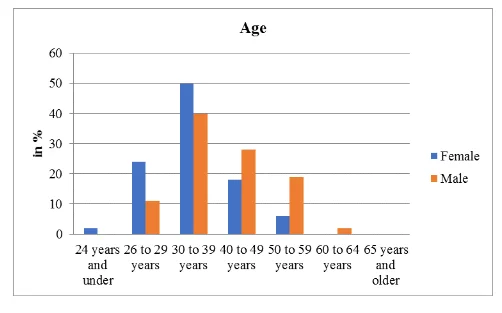
The respondents are asked about the duration they live in London. On this question, most of the respondents (about 40%) have mentioned that they are living in London for more than 10 years. About 28% of respondents have stated that they are residing in London for about 5 to 10 years, and only 19% of respondents have mentioned that they are living in London for about one to 5 years (see the following figure).
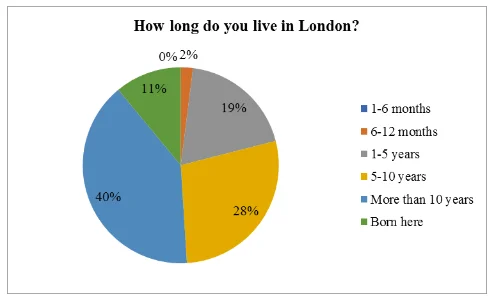
Concerning the number of households, it can be observed that the majority of the respondents (about 58%) have 1 to 2 families. Furthermore, 38% of respondents also have 3 to 4 households, and only 4% of respondents have 5 and more families (see the following figure).
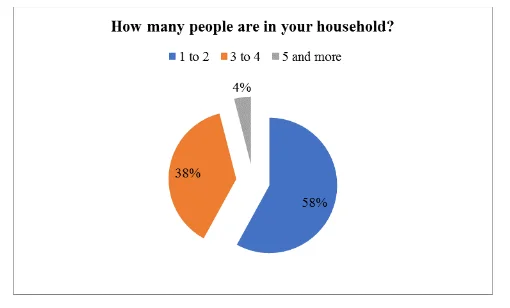
To understand the frequency of purchasing new clothes, the respondents are asked how often they are buying clothes. On this question, the majority of the respondents (about 64%) have mentioned that they purchase new clothes once a month. Furthermore, 33% of respondents have stated that they are buying clothes twice a month, and only 3% of respondents mentioned that they purchase clothes once a week (see the following figure). This indicates that among the respondents, there is a trend of buying clothes frequently, which can be the outcome of overproduction by the brands, which pushes them to purchase the apparel products, even if they are not required. The production creates an unnecessary demand among people to buy clothes too often to demonstrate up to date fashion trend.
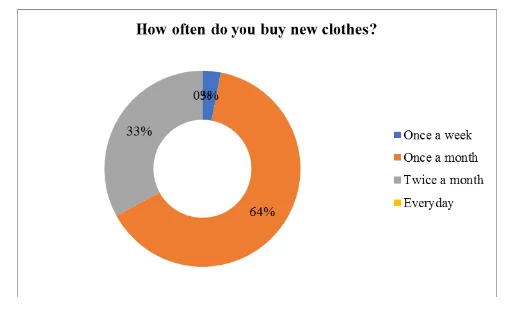
To understand the spending pattern of respondents on clothes, they are asked how much they spend on clothing per month. The majority of the respondents (about 59%) on this question have stated that they spend about £60 to £100 per month on clothing. About 34% of respondents have mentioned that they spend about £30 to £50 per month on clothing, and only 5% of respondents said they pay above £100 for clothing in a month (see the following figure). This signifies that a significant amount of money is allocated to spending on clothing due to the fast fashion trend among the people. This expenditure on expenditures can be attributable to overproduction, which makes the producers give various promotions to lure customers for purchasing them, creating a culture of fast fashion.
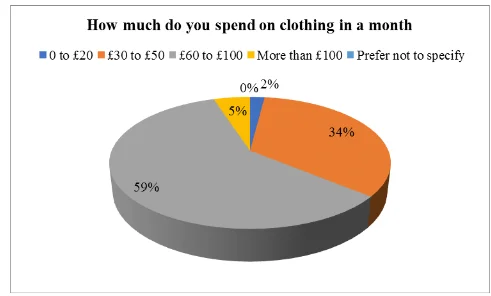
The respondents are also asked about employment status. In this context, most of the respondents (about 57%) have mentioned that they have full-time employment. About 36% of respondents have also said that they do part-time jobs. Only 6% of respondents have stated that they are self-employed (see the following figure). This specifies that most of the respondents have a specific income source, due to which they can spend much on clothes.
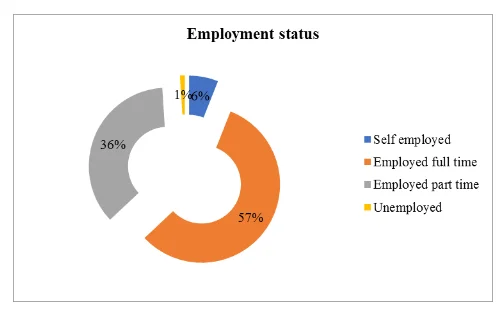
In the next question, the respondents are asked what they will do with not needed clothes. On this question, the majority of the respondents (about 42%) have mentioned that they give new clothes or casual clothes to others. 31% of respondents also said that they kept the clothes in wardrobe. 23% respondents mentioned that they throw clothes to containers and only 4% respondents stated that they hand over the clothes to charity shops (see following figure). This finding indicates that due to overproduction, significant number of clothes goes unused or not needed. Since they are fast fashion products, most of the clothes become out of fashion within few months, which generate the requirements for purchasing new clothes. This not only led to wastage of natural resources for overproduction of such huge clothes, but also creates environmental hazards. Such resources or money spend on clothes can be utilized in other aspects of economic and environmental development.
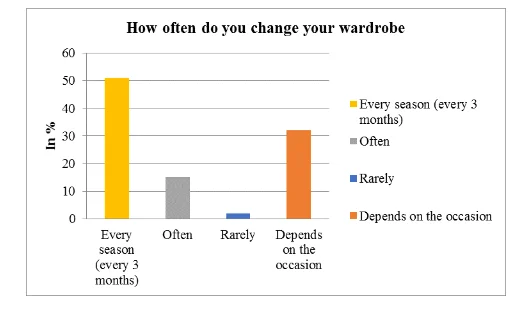
Finally, the respondents are asked about the factors which tempt them to purchase a new item or new cloth. In this question, majority of the respondents (about 64%) have mentioned new looks or new design. Therefore, majority of the clothing brands always work on developing new product designs so that they can attract the customers for purchasing new clothes. This attributes to the culture of fast fashion among respondents. Accordingly, 22% respondents also stated that fast fashion movement is the key factor which tempts to purchase new item (see following figure). This fast fashion trends generate needs for apparel in every season, even when there is no requirement or there is abundant clothes in wardrobe. 14% respondents stated that discounts tempt them to purchase new items. This indicates that sometimes when there are unsold stocks due to overproduction, brands gives discounts, which also attracts the customers to purchase clothes.
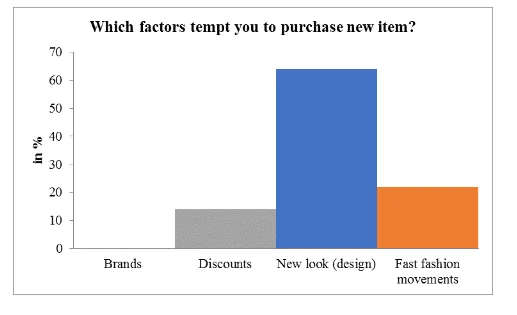
Following is the descriptive statistics of the factors of purchasing new items.
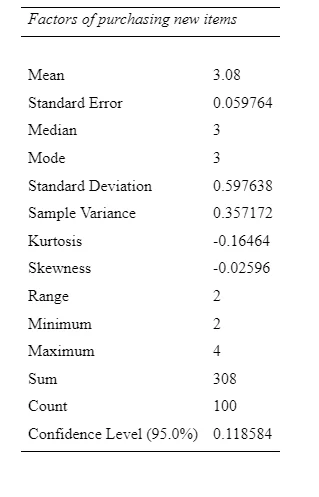
In order to understand the relationship between frequency of purchasing new clothes, spending on clothing, frequency of changing wardrobe and what respondents do with not needed clothes, a correlation analysis is conducted (see following table).
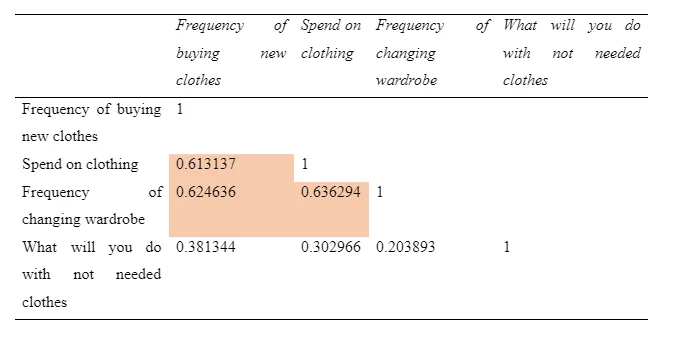
From the above analysis, it can be observed that the value of correlation coefficient between spending on clothing and frequency of buying new clothes and frequency of changing wardrobe is observed to be 0.613 and 0.636 respectively, which are positive and much closer to 1. Therefore, it can be stated that strong positive relationship exists between the variables. Then again, the correlation coefficient between frequency of buying wardrobe and frequency of changing clothes is also observed to be 0.624, which is positive and much closer to 1. Therefore, strong positive relationship exists between these variables. However, the correlation coefficient with ‘What will you do with not needed clothes’ and frequency of buying new clothes, frequency of changing wardrobe and spending on clothes are observed to be 0.318, 0.302 and 0.203 respectively, which are positive but not closer to 1. Therefore, the relationships between these variables are positive but weak. Based on this analysis, it can be stated that high spending on clothing is related with high frequency of changing wardrobes and high frequency of purchasing new clothes within the respondents. Nevertheless, their activities on unnecessary clothes cannot be established statistically. To understand the significance of the relationship between variables, regression analysis is conducted. The key dependent variable in this context is frequency of buying new clothes, which is measured against key independent variable, i.e. spending on clothing (see following table).
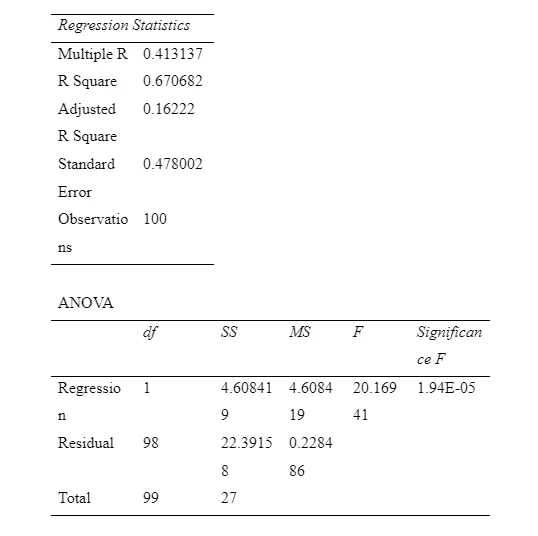


From the above analysis, it can be observed that the value of R2 is 0.67, which specifies that any changes in the spending pattern of respondents is related with about 67% changes in the frequency of purchasing new clothes, which is quite significant. Furthermore, the P value of the analysis is observed to be about 1.94E-05, which is less than 0.05. Therefore, it can be mentioned that the relationship between the variables are statistically significant. On the basis of the analysis, it can be stated that the spending pattern of respondents have statistically significant relationship with buying behavior in terms of changing the wardrobes as well as purchasing new clothes.

Chapter 5: Conclusion and Recommendation
5.1. Conclusion
From the analysis of the research paper, it can be comprehended that the overproduction of clothes in the fast fashion industry impacts the decision-making process of customers. The fashion business in the UK is vast and clothes purchased are more per person. The worth of the UK fashion industry is increasing, thus impacting the economy. However, it is determined from the study that about more than $500 billion value is lost due to the overproduction of clothes and underutilization. The production is impacting the natural resources and the lifestyle of people in the UK and also the ability to make the proper decisions. The concern that has been evaluated and analysed is that fast fashion is generating excessive waste and is encouraging overconsumption. The decision-making behaviour of customers is changed as it attracts customers who aim to improve their wardrobe regularly as per the changing trends. Fast fashion attracts consumers’ who are fashionable and copy the pattern from luxurious retailers. The argument or the criticism faced by the fast fashion business model is that it leads to overconsumption and excessive waste. The quality of the clothes is also questioned, thus leading to excessive trash with low value. Through the help of the questionnaire survey results and analysis of the respondent's view, it is determined that the overproduction of fast fashion is due to the outburst of new designs, which means never-ending production of fashionable clothes with low quality impacting the industry and decision-making ability of consumers. It can be further stated from the research that customer behaviour in the fast fashion industry is not the same. With the advancement of digital technology, customers are aware of the brands and clothing materials; thus, overproduction is giving rise to wastage and sustainability issues. Decision making of customers changes with the changing needs; therefore, the internal and external factors give rise to overproduction. For the business to be successful, it is essential that the fast fashion industry understand the needs and motivates consumers to purchase value. With the production of fashionable clothes, the environment is impacted, and natural resources are being reduced, creating a threat to the environment. It can be concluded from the study that about 30% of clothes are not sold, and other stocks are given discounts to influence the decision-making behaviour of customers.
5.2. Recommendation and Future Research
The fashion industry of the UK is growing, and people are attracted to fashionable clothes. It is recommended that fast fashion needs to focus on affordability and sustainability so that the overproduction can be managed. The research stated that the over the purchase of clothes is because of a lack of knowledge and understanding about sustainable consumption practices. It is recommended that the fast fashion industry needs to understand the change, thus impacting customer buying decisions. Customers need to understand their requirements and make purchase decisions based on the quality and sustainability of products. It is further recommended to analyse the reasons for overproduction, which is the lack of knowledge about the changing needs of people. The industry needs to manage environmental hazards by managing the decision making process and identifying the changing needs of customers. The fast fashion industry needs to acknowledge the changing behaviour and decision-making behaviour based on changing market trends and clothes quality. It is recommended to focus upon the oversupply of the textiles price of the garments are not less, making it easier to purchase for the people of the UK. The study helps to draw upon future research issues, which are about the aspect of the overproduction and decision-making behaviour of customers. The areas for future research include consideration to investigate the potential solutions to limit the consumption of clothes, thus reducing production. Another aspect is to motivate people to make wise decisions and fast fashion industries to understand the consumption norms to minimize overproduction and reduce wastage impacting the environment. The future area of research is to access consumer knowledge regarding sustainable practices in the fast fashion industry. The fast fashion industry is fundamentally unsustainable because of affordability, sustainability, and quick responses.
References
- Bergh, D. D. & Ketchen, Jr., D. J., 2009. Research Methodology in Strategy and Management, Volume 5. Emerald Group Publishing.
- Birtwistle, G. & Moore, C.M., 2007. Fashion clothing – where does it all end up? International Journal of Retail & Distribution Management, Vol. No.35, pp. 210–216.
- Birtwistle, G. & Moore, C.M., 2007. Fashion clothing – where does it all end up? International Journal of Retail & Distribution Management, Vol. No.35, pp. 210–216.
- Creswell, J. W., 2013. Research Design: Qualitative, Quantitative, and Mixed Methods Approaches. SAGE Publications
- Forsman, L. & Madsen, D., 2017. Consumers’ Attitudes Towards Sustainability And Sustainable Labels In The Fashion Industry – A Qualitative Study. The Swedish School of Textiles, pp. 1-76.
- Gam, H.J., 2011. Are Fashion-Conscious Consumers More Likely to Adopt Eco-Friendly Clothing? Fashion Marketing and Management: An International Journal, Vol. No. 15, No. 2, pp. 178-193.
- Gam, H.J., 2011. Are Fashion-Conscious Consumers More Likely to Adopt Eco-Friendly Clothing? Fashion Marketing and Management: An International Journal, Vol. No. 15, No. 2, pp. 178-193.
- Grubor, A. & Milovanov, O., 2017. Brand Strategies In The Era Of Sustainability. Interdisciplinary Description Systems, Vol. No. 15, pp. 78-88.
- Kozlowski, A., Searcy, C. & Bardecki, M.,2018. The redesign canvas: Fashion design as a tool for sustainability. Journal of Clean Production, Vol. No. 183, No. 6, pp. 194-207.
- Lu, L., Bock, D., & Joseph, M., 2013. Green marketing: what the Millennials buy. Journal of Business Strategy, Vol. no.34, No. 6, pp. 3-10.
- Lu, L., Bock, D., & Joseph, M., 2013. Green marketing: what the Millennials buy. Journal of Business Strategy, Vol. no.34, No. 6, pp. 3-10.
- Manchiraju, S. & Sadachar, A., 2014. Personal values and ethical fashion consumption. Journal of Fashion Marketing and Management, Vol. No. 18, No. 3, pp. 357-374.
- McNeill, L. & Moore, R., 2015. Sustainable Fashion Consumption And The Fast Fashion Conundrum: Fashionable Consumers And Attitudes To Sustainability In Clothing Choice. International Journal of Consumer Studies, Vol.No. 39, No. 3, pp. 212-222.
- McNeill, L. & Moore, R., 2015. Sustainable Fashion Consumption And The Fast Fashion Conundrum: Fashionable Consumers And Attitudes To Sustainability In Clothing Choice. International Journal of Consumer Studies, Vol.No. 39, No. 3, pp. 212-222.
- Onwuegbuzie, A. J. & Leech, N. L., 2007. Sampling Designs in Qualitative Research: Making the Sampling Process More Public. The Qualitative Report, Vol. 12, No. 2, pp. 238-254.
- Resta, B. & et.al., 2016. Enhancing Environmental Management In The Textile Sector: An Organizational-Life Cycle Assessment Approach. Journal on Clean Production, Vol. No. 135, No. 9, pp. 620-632.
- Resta, B. & et.al., 2016. Enhancing Environmental Management In The Textile Sector: An Organizational-Life Cycle Assessment Approach. Journal on Clean Production, Vol. No. 135, No. 9, pp. 620-632.
- Shen, D., Richards, J. & Liu, F., 2013. Consumers’ awareness of sustainable fashion. Journal of the Marketing Management, Vol.No. 23,No. 2, pp. 134-147.
- Shen, D., Richards, J. & Liu, F., 2013. Consumers’ awareness of sustainable fashion. Journal of the Marketing Management, Vol.No. 23,No. 2, pp. 134-147.
- Valor, C., Carrero, I. & Redondo, R., 2014. The Influence of Knowledge and Motivation on Sustainable Label Use. Journal of Agricultural and Environmental Ethics, Vol. no.27, No. 4, pp. 591–607.
- 24/7 Customer Support
- 100% Customer Satisfaction
- No Privacy Violation
- Quick Services
- Subject Experts



